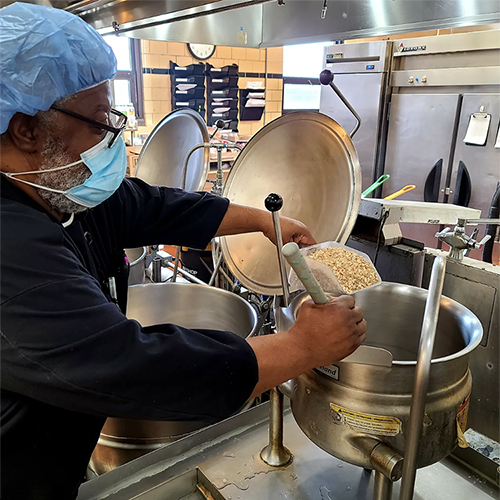Build healthier food environments for your patrons through education, promotion, and marketing of healthy foods and beverages at your facility.
Healthy food environments include the food itself – whole or minimally processed – as well as community culture. Hospitals can promote community health by offering culturally relevant, nourishing food that honors communities’ food traditions and protects against food-related chronic disease.
As promoters and protectors of community health, hospitals can use procurement and related strategies to foster healthy and resilient communities.

Regional, regeneratively grown oats being prepared into oatmeal for patient trays at SFMC.
(Golda Ewalt, OSF HealthCare Saint Francis Medical Center)
Initiatives
Below are a few validated strategies to assist hospitals with building healthier food environments through education, promotion and marketing.
Create menus that highlight foods with high nutritional value and low environmental impact.
- Focus on whole and minimally processed foods when developing your menu and purchasing goods.
- Shift food spending toward whole, plant-based foods, including vegetables, fruits, whole grains, legumes, nuts, and seeds, with an aim for 50% of total spend across these categories.
- If dairy milk is offered, purchase fat-free, low-fat, or reduced fat milk with no added sweeteners.
- Offer minimally processed, plant-based alternatives where dairy products are offered. (i.e., products made with soy, almond, rice, oat, or other plant-based ingredients).
- Offer whole or minimally processed, plant-based main dishes at each meal service.
Where animal products are served, focus on health-promotion for people and the planet.
- Choose animal products produced without the use of antibiotics for disease prevention or other routine purposes.
- If meat is offered, reduce purchases of red and processed meat. Increasing the purchase and menuing of high-protein plant foods can be a useful strategy for reducing meat on the menu while generating more health and environmental benefits associated with these foods.
- If meals featuring crustaceans (e.g., shrimp, lobster, crayfish, crabs) are prepared at your facility, use the most humane methods for cooking. Ensure that live boiling without stunning is prohibited.
Develop and implement a nutritional policy that covers all prepared and packaged foods, meeting or exceeding the following guidelines (taken from the Federal Food Service Guidelines).
- All individually portioned food items contain ≤ 480 mg sodium per serving. Purchase “low sodium” (≤ 140 mg sodium per serving) whenever possible.
- Added sugars (including natural and artificial sweeteners) in individually portioned food items should be no more than 10% of Daily Value per serving (DV is 50g).
- Grain products purchased are whole grain rich.
- Healthy beverages* make up the majority of beverage options offered.
- If juice is purchased, all juice purchased is 100% fruit juice with no added sweeteners, and vegetable juice is low sodium as per FDA definitions.
- Eliminate food additives including artificial coloring and flavoring.
|
*Defining healthy beverages These include: water (filtered tap, unsweetened, seltzer, or infused), milk (plain, unsweetened), non-dairy milk alternatives (plain, unsweetened), and teas and coffee (unsweetened with only naturally occurring caffeine). Diet drinks with artificial sweeteners are not considered healthy beverages and should be eliminated. To the best ability, beverages should be dispensed by tap or fountain, and reusable beverage containers should be encouraged. |
Prioritize the preparation of all vegetables and protein, including fish, poultry, meat, or meat alternatives in a way that utilizes vegetable-based oils or reduces added fat (broiling, grilling, baking, poaching, roasting, or steaming).
- Limit the use of deep frying to whole/minimally processed foods (e.g., plantains) and eliminate use of frozen or prepared items that are deep fried upon purchase.
Partner inspirationHear from eight partner hospitals about why they are choosing plant-forward meals for their patient trays and cafeteria lines. |
Create a food environment that supports health.
- Adopt healthy product placement strategies. Some examples include:
- Prominently feature fruit, non-fried vegetables, and/or water in high-visibility locations.
- Display healthy beverages in eye level sections of beverage cases (if applicable).
- Remove ultra-processed foods from checkout register areas/point-of-purchase.
- If “combination meals” that include an entree, side, and beverage are offered, offer water as a beverage alternative, and offer fresh fruit or a non-fried vegetable as a side.
- Price healthy foods and beverages competitively with non-health promoting alternatives.
Montefiore Health SystemClinicians at Montefiore Health System in the Bronx, New York, saw the power for plant-based diets to change health outcomes for their patients and have made strides in promoting vegetarian and vegan menus to patients facing chronic disease and food insecurity. |
Provide nutrition education
- Make nutrition information and ingredient lists available for each menu item.
- Implement community health and nutrition education. Examples include:
- An interactive or educational on-site garden with supportive programming
- Free cooking demonstrations paired with related nutrition tips
- Develop and implement an employee wellness program that includes health and nutrition education, or support an existing program with health and nutrition resources.
Brigham and Women’s Hospital SystemIn the summer of 2022, two hospitals in the Brigham and Women’s Hospital System participated in the Plant Powered 30 Challenge, Practice Greenhealth’s plant-forward promotion program that challenges staff to eat one plant-forward meal a day for 30 days. More than 90 Brigham and Women’s Hospital System staff members participated, and prizes were offered to all its winners. All hospitals participating in Plant Powered 30 receive promotional materials and menu ideas to support implementation. |
